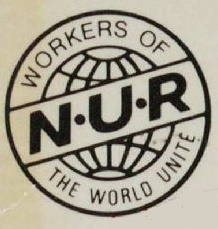Top Qs
Timeline
Chat
Perspective
National Union of Railwaymen
Trade union of railway workers in the United Kingdom From Wikipedia, the free encyclopedia
Remove ads
The National Union of Railwaymen was a trade union of railway workers in the United Kingdom. The largest railway workers' union in the country, it was influential in the national trade union movement.[1]
Remove ads
History
Summarize
Perspective
The NUR was an industrial union founded in 1913 by the merger of the Amalgamated Society of Railway Servants (founded 1872), the United Pointsmen and Signalmen's Society (founded 1880) and the General Railway Workers' Union (founded 1889).[2]
The NUR represented the majority of railway workers, but not white-collar workers, who were members of the Railway Clerks' Association (founded 1897, later the Transport Salaried Staffs' Association). NUR membership was open to drivers and firemen but most chose instead to be members of the Associated Society of Locomotive Engineers and Firemen (founded 1880).
In 1914 the NUR joined forces with the National Transport Workers' Federation and Mining Federation of Great Britain to form the Triple Alliance – perhaps an unfortunate name, as the same year the Triple Entente of Britain, France and Russia and the Triple Alliance of Germany, and Austria-Hungary (albeit without Italy) went to war.
In 1919 the NUR and ASLEF jointly organised the 1919 United Kingdom railway strike, which prevented a proposed wage reduction and won an eight-hour maximum working day.[3] The NUR formed Federation agreements with ASLEF in 1903[4] and 1982 but both were short-lived.
The NUR had 408,900 members in 1945, making it the fifth largest union in Britain. Its membership fell to 369,400 in 1956 and 227,800 in 1966.[5]
Following the formation of British Rail, the majority of NUR members worked for the nationalised organisation. However, other members worked for London Transport, the National Freight Corporation and various smaller companies. It also recruited British Rail workers in associated industries, such as its hotels, docks and harbours, and on the Sealink ferries.[1]
In 1990 the NUR merged with the National Union of Seamen to form the National Union of Rail, Maritime and Transport Workers (RMT) and ceased to exist as a separate union.
Remove ads
Election results
Summarize
Perspective
The union sponsored numerous Labour Party Parliamentary candidates, many of whom won election.
Remove ads
Leadership
General Secretaries

- 1913: James Edwin Williams[34]
- 1916: James Henry Thomas[34]
- 1931: Charlie Cramp[34]
- 1933: John Marchbank[34]
- 1943: John Benstead[34]
- 1948: Jim Figgins[34]
- 1953: Jim Campbell[34]
- 1957: Sidney Greene[34]
- 1975: Sidney Weighell[34]
- 1983: Jimmy Knapp[34]
Presidents
- 1913: Albert Bellamy[35]
- 1918: Charlie Cramp[35]
- 1920: William James Abraham[35]
- 1922: John Marchbank[35]
- 1925: William Dobbie[35]
- 1928: J. Gore[35]
- 1931: William Dobbie[35]
- 1934: Joseph Henderson[35]
- 1937: Walter T. Griffiths[35]
- 1939: J. H. Potts[35]
- 1942: Frederick Burrows[35]
- 1945: Eddie Binks[35]
- 1948: William Tindall Potter[35]
- 1951: Harry Franklin[35]
- 1954: Jim Stafford[35]
- 1957: Tom Hollywood[35]
- 1958: Charles W. Evans[35]
- 1961: Bill Rathbone[35]
- 1964: Frank Donlon
- 1967: Frank Lane
- 1970: George Chambers
- 1972: Harold McRitchie
- 1975: Dave Bowman
- 1978: Alun Rees
- 1982: Tom Ham
- 1984: George Wakenshaw
- 1987: Alan Foster
- 1990: John Cogger
See also
References
Sources and further reading
External links
Wikiwand - on
Seamless Wikipedia browsing. On steroids.
Remove ads

